For now, love yourself and enjoy this one ...
Now love yourself and enjoy this one ...
This is no mere dessert! This is Banana Cake—a subtly sweet, chocolate-frosted delight made with health-conscious ingredients to rid your palate of guilt.
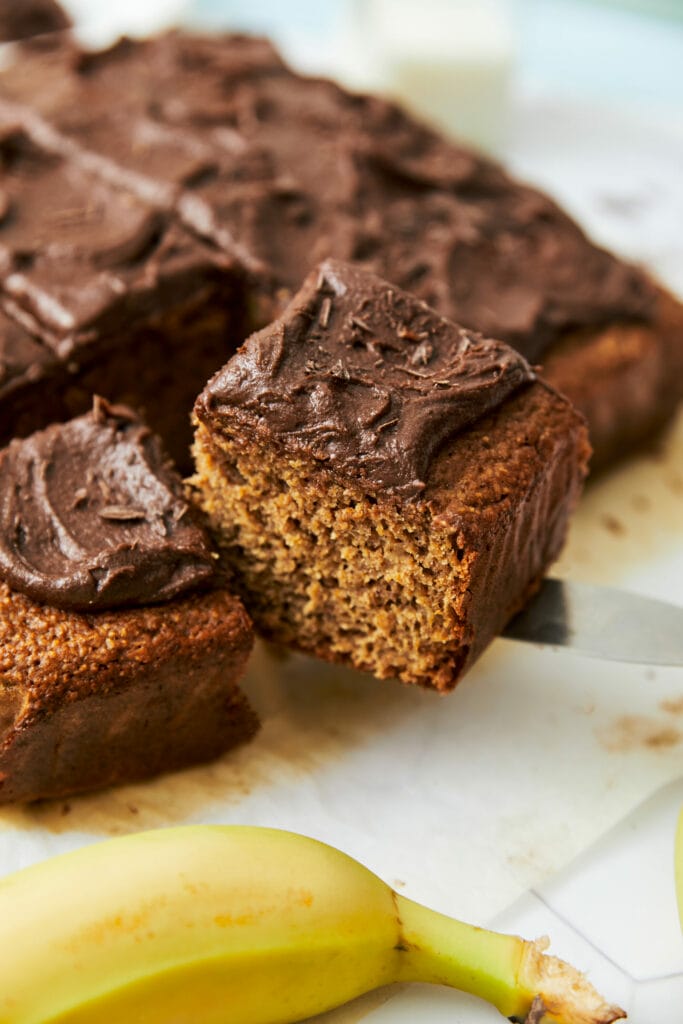
Table of Contents
Eat the sweet stuff first—that’s my motto.
Okay, I admit it. That’s not my motto. But it very well could be if all the sweet stuff were as healthy as this banana cake. I made a concerted effort to replace as much as I could the icky ingredients (nutritionally speaking, that is). In their stead are healthier versions like whole wheat flour, Greek yogurt, applesauce, and coconut sugar. The bottom line? You get all the taste without the needless fat, sugar, calories, and whatever else your body may consider surplus to requirements.
In fact, I felt I was doing so well with the batter that I included the ingredients and instructions for frosting, too. Don’t feel obligated to use it; the cake will taste great without it. But if you want something a bit more hedonistic, slather it on. I continue the trend of making healthy substitutions (see cocoa powder and almond milk) so it’s not too crazy, but it’s an option for those with something, perhaps, to celebrate.
Is This Banana Cake Healthy?
Is banana cake healthy? Not really. Is THIS banana cake healthy? Relatively speaking, yes! That’s because we remove the bad stuff and replace it with ingredients that appreciate that you can’t be eating like an eight-year-old all your life. We use whole wheat flour, applesauce, Greek yogurt, unsweetened cocoa powder, and almond milk where we could have used more… malignant foods.
Isn’t Cocoa Powder Bad for You? It Sounds Unhealthy
Unsweetened cocoa powder comes to us from the cocoa bean, the same bean responsible for all that milk chocolate you devour at Easter (and Christmas and Halloween). The difference is that those chocolate bunnies contain cocoa butter and sugar, which gives it that sweet taste and creamy texture. Cocoa powder, meanwhile, is rich in antioxidants, iron, magnesium, and potassium, as well as some fiber and protein; it regulates brain function, heart health, and blood-sugar levels. Sure, it’s bitter, but given all you get, I’d say it’s a welcome addition to my baked goods.
INGREDIENTS
The Banana Cake:
- 2 1/2 cups whole wheat flour
- 1 1/4 tsp baking powder
- 1 tsp baking soda
- 1/2 tsp sea salt
- 3 very ripe bananas, mashed
- 3/4 cup coconut sugar
- 1/2 cup unsweetened applesauce
- 4 large eggs, lightly whisked
- 1/4 cup Greek yogurt
- 1 tsp pure vanilla extract
The Chocolate Frosting:
- 1/2 cup unsalted butter, melted
- 3 cups powdered sugar, sifted
- 1/4 cup unsweetened cocoa powder
- 1/4 cup almond milk
- 1 tsp pure vanilla extract

INSTRUCTIONS
Bake
Combine ingredients, pour into a greased pan, and bake at 350°F.
Frost
Mix butter, cocoa, sugar, milk, and vanilla.
Serve
Cool, frost, slice.
Devour!
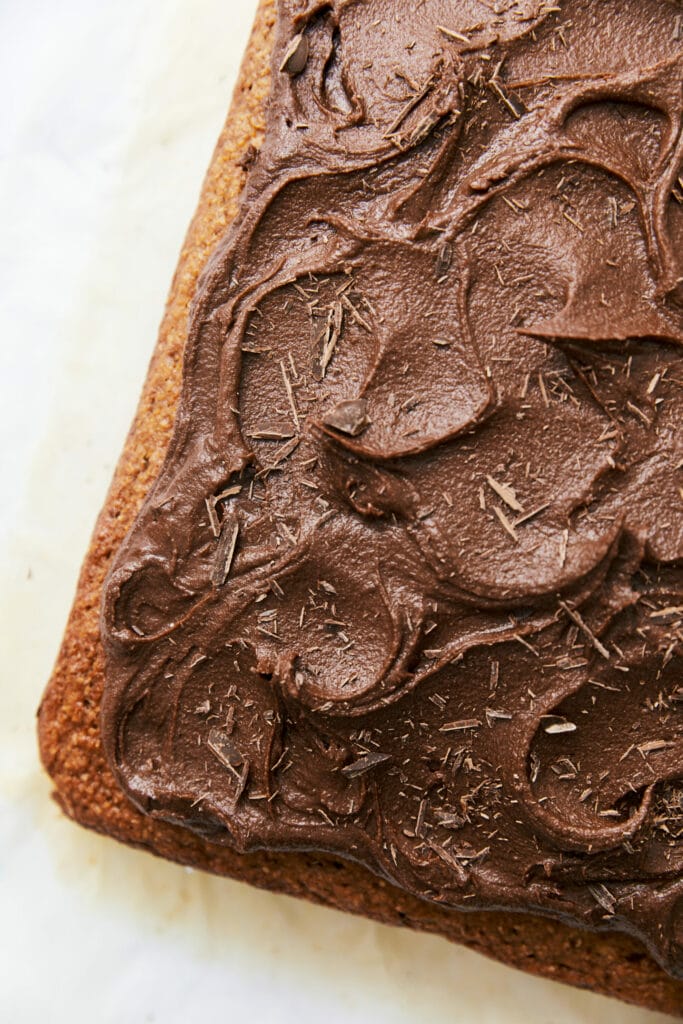
FAQs & Tips
Let the cake cool completely. You can then leave it on the counter (just wrap it in plastic, foil, or cover it) for up to three days. Or you can wrap it up and store it in the fridge for up to five days. You can also freeze the cake for up to a month. I would wrap it first in plastic then in aluminum foil, or store it in an airtight container. Let it thaw in the fridge overnight.
Both are leavening agents (i.e., they help your baked goods rise) but whereas baking soda (a.k.a., sodium bicarbonate) needs an acid to be activated, baking powder doesn’t. That’s because the latter is actually baking soda combined with its own acid built in (i.e., cream of tartar). Use baking soda when one of the other ingredients is an acid; use baking powder when there isn’t an acid present and you need to supply your own.
While many will point to the joy of eating warm cake straight out the oven, I prefer to refrigerate my cakes for a day or two. This way the bananas can do two things: infuse the entirety of the cake with its sweetness, and distribute its moisture. I love moist cake with a bit of density to it, so this is how I do things. Of course, I have to admit, that warm cake does sound pretty good.
No. Extract is the genuine article. It contains actual vanilla and is stronger in taste than essence, which is synthetic and may not contain any vanilla at all. Essence, you’ll find, is usually cheaper but will require you to use more to achieve a similar level of vanilla flavor.
Use the ol’ toothpick test. Insert it into the cake at its thickest point. If it comes out dry with the occasional crumb, it’s ready. If it is wet, it needs more time.

Serving Suggestions
I’ve made this banana cake as healthy as I can. If that doesn’t mean anything to you, then now’s your chance to get wild. This dessert becomes a REAL treat were you to add ice cream, whipped cream, and/or chocolate syrup. Less devious are strawberries, blueberries, banana slices, crushed nuts, maple syrup, and/or honey. Look on this like you would a chocolate birthday cake.


Banana Cake
Ingredients
The Banana Cake:
- 2 1/2 cups whole wheat flour
- 1 1/4 tsp baking powder
- 1 tsp baking soda
- 1/2 tsp sea salt
- 3 very ripe bananas mashed
- 3/4 cup coconut sugar
- 1/2 cup unsweetened applesauce
- 4 large eggs lightly whisked
- 1/4 cup Greek yogurt
- 1 tsp pure vanilla extract
The Chocolate Frosting:
- 1/2 cup unsalted butter melted
- 3 cups powdered sugar sifted
- 1/4 cup unsweetened cocoa powder
- 1/4 cup almond milk
- 1 tsp pure vanilla extract
Instructions
Banana Cake:
- Preheat your oven to 350°F. Grease a 9×9-inch baking pan with a little coconut oil and dust with flour to prevent sticking.
- In a large bowl, whisk together the whole wheat flour, baking powder, baking soda, and sea salt.
- In another bowl, mash the bananas until smooth. Stir in the coconut sugar, applesauce, eggs, Greek yogurt, and vanilla extract until well combined.

- Gently fold the banana mixture into the dry ingredients, just until incorporated.
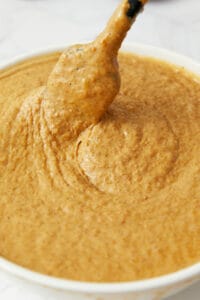
- Pour the batter into the prepared pan and smooth the top with a spatula. Bake for 30-35 minutes. Let the cake cool completely in the pan on a wire rack.
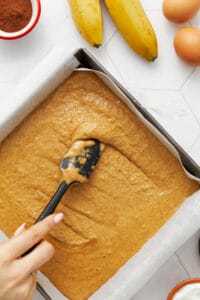
Chocolate Frosting:
- In a medium bowl, whisk the melted butter with the cocoa powder until smooth.
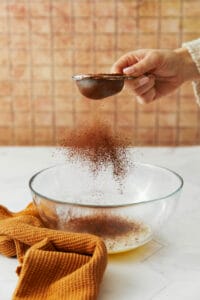
- Gradually add the powdered sugar, alternating with the almond milk, and beat until you reach a spreadable consistency. Add the vanilla extract and mix well.

- Once the cake is cool, spread the frosting evenly over the top. Slice and serve!

Nutrition
The post Banana Cake appeared first on Food Faith Fitness.
References:
By: FoodfaithfitnessTitle: Banana Cake
Sourced From: www.foodfaithfitness.com/banana-cake/
Published Date: Mon, 18 Mar 2024 11:25:28 +0000
Frequently Asked Questions
Why is organic foods important?
For our health, organic produce is crucial. Organic produce is the best way to eat healthy foods. It's not only better for us but also it's more sustainable as it doesn't rely upon pesticides and fertilers.
Organic farming uses natural methods for growing crops without using harmful chemicals. This means fewer environmental pollutants, making it safer for humans and animals. Organic food is a way to help the environment and protect yourself.
The benefits of organic food go beyond our health, though. We are all well aware of how harmful processed food can make our bodies feel. But did you know that most organic fruits and vegetables aren't treated with chemical spray either? It means that organic fruits and vegetables taste better, last longer, and are brighter.
Organic food is so important. It's healthy for you and the planet.
What are organic food products?
Organic produce does not contain synthetic fertilizers, pesticides and sewage sludge. It is also grown without irradiation or genetic engineering. There is no use of growth hormones and no animal testing. These crops can naturally grow, so no chemicals are used by farmers to combat pests or weeds.
Organic farming practices also maintain soil quality by reducing erosion and conserving water resources. In addition, organics are better for our health because they contain more nutrients than conventional food. Organic products are typically higher in fiber and lower in fat and calories than conventionally produced ones.
What is the difference in organic and non-organic foods?
Organic food is grown without the use of pesticides or chemical fertilizers, sewage effluent, radiation, or genetic modification. Organic farming practices are good for soil health, water quality, animal welfare, and the environment.
Inorganic food is grown with pesticides and chemical fertilizers. Radiated foods are those that have been exposed to radiation. Genetically modified organisms, or GMOs, are created using biological engineering techniques.
"Organic" and "natural" are often interchangeable. Natural does not necessarily have to mean organic. Some products labeled "natural" may also contain synthetic ingredients.
Organic produce is typically more nutritious than conventional produce because the soil contains fewer harmful chemicals and pesticides. Organic farmers also don't use synthetic fertilizers or hormones, pesticides, or antibiotics.
What is organic food?
Organic food is not produced with pesticides or artificial fertilizers. These chemicals can cause health problems in organic foods.
Organic food can be grown without chemical fertilizers, pesticides herbicides, fungicides, and other harmful substances. These chemicals can be harmful to both animals and people.
Inorganic food is meat, fish, eggs and dairy products, including butter, yogurts honey, yogurts, butter, cream, cheese, butter, yogurts, honey and grains.
Organic refers the way an agricultural product grows. Organic farming employs natural methods and soil amendments for growing crops. Conventional agriculture uses pesticides or fertilizers.
Foods labeled as organic must meet strict guidelines by the U.S. Department of Agriculture (USDA). The National Organic Program Standards state that organic food must be freed from banned substances like antibiotics, growthhormones, genetically altered organisms (GMOs) and industrial solvents. Organic food must be grown without the use of toxic chemicals or petroleum-based fertilizers.
Statistics
- Cosmetic brands such as Laurel and Rose Mira are 100 percent organic and have a wide array of skincare products. (en.wikipedia.org)
- When packaged products indicate they are “made with organic [specific ingredient or food group],” they contain at least 70% organically produced ingredients. (usda.gov)
- Popular clothing brands, like Patagonia, are labelled as organic by using 100 percent organic cotton for many of their styles. (en.wikipedia.org)
- According to a study performed by consumerreports.org, organic products, compared to non-organic products, ranged anywhere from 13 percent cheaper to 303 percent more expensive. (en.wikipedia.org)
External Links
[TAG36]
[TAG39]
[TAG41]
- A Review of Journal of Toxicology and Environmental Health: Cancer Risk and Occupational Pesticide Expositions: Part B: Vol 15, Number 4
- Genetically modified foods: Safety, Risks and Public Concerns - A Review - Journal of Food Science and Technology
[TAG44]
How To
What you should know about organic food
Organic foods are plants and animals grown without pesticides, chemical fertilizers, or additives. They can be produced without the use of genetic engineering or ionizing radiation. It must not contain any artificial colours, flavour enhancers, flavor enhancers, and preservatives. It should not contain genetically modified animals (GMOs).
When Justus von Liebig, a chemical chemist, coined "organic", which means "life-giving," to describe the properties in manure, the term "organic" was used for the first time. The term organic is often associated with food production. In this context, organic means that the product contains only naturally occurring substances such as proteins, carbohydrates, fats, and minerals that occur in nature.
The consumption of organic foods has risen dramatically in the past decades. According to statistics, approximately 50% of the world’s population consumes at minimum one organic product each day. This number is rising and is expected increase to 70%, 90%, and 80% by 2020.
There are many reasons consumers choose organic products. Some like the taste, others prefer them because they believe organic produce is healthier, while some think organic farming is more environmentally friendly. Non-organic products are often chosen because they do not pose ethical issues regarding the treatment of farm workers or animals.
Organic foods are more expensive than those made from conventional food, though prices may vary by country and region. Organic food prices are affected by many factors. One factor is the availability of land suitable for organic agriculture. Another factor is the cost of inputs, labour and materials required for organic agriculture. There are other factors such as transportation costs, marketing and taxes. In Europe, for instance, the average price for organic food in Europe is 10% higher than its regular price.
Below are the main differences between conventional and organic foods.
- Organic produce is free from synthetic fertilizers, growth regulators, hormones, and antibiotics.
- Organic livestock are fed grasses, grains and legumes rather than corn or soybean meals.
- Organic milk comes only from cows who are fed hay and pasture grasses all-naturally.
- All raw materials used for organic manufacturing are certified organic.
- No pesticides or other harmful chemicals are allowed during organic fruits and vegetables' growth and processing stages.
- Organic meats, poultry, and seafood don't require radiation.
- Raw nuts and seeds are soaked before use.
- Organic cooking uses only healthy oils.
- Organic eggs were laid by hens. They can also be used in outdoor areas.
- Bees use traditional methods to extract organic honey.
- Organic chocolate uses sugar and beans that have been grown and processed organically.
- Organic wines are free from chemical additives.
- The plants used to make organic tea are hand-picked.
- Organic cotton is grown with no pesticides or herbicides.
- Organic flours and cereals are free from artificial colours, preservatives, or flavors.
- All-natural shampoos and soaps don't contain harsh chemicals.
- All-natural cosmetics are safe and gentle for your skin.
- All natural cleaning remedies are biodegradable.
- All natural products for the body are hypoallergenic, dermatologically tested, and hypoallergenic.
- All-natural personal hygiene products are fragrance-free and can be used safely by babies.
- All-natural baby formula doesn't contain bovine serum or animal rennet.
 |
[TAG46]This Irish-inspired colcannon soup is easy to make with creamy potatoes, kale and cheddar cheese. The last time I made colcannon (traditional Irish mashed |
 |
[TAG47]This Irish kale colcannon recipe is perfectly buttery and fluffy and easy to make with a handful of basic ingredients. St. Patrick’s Day is just around the |
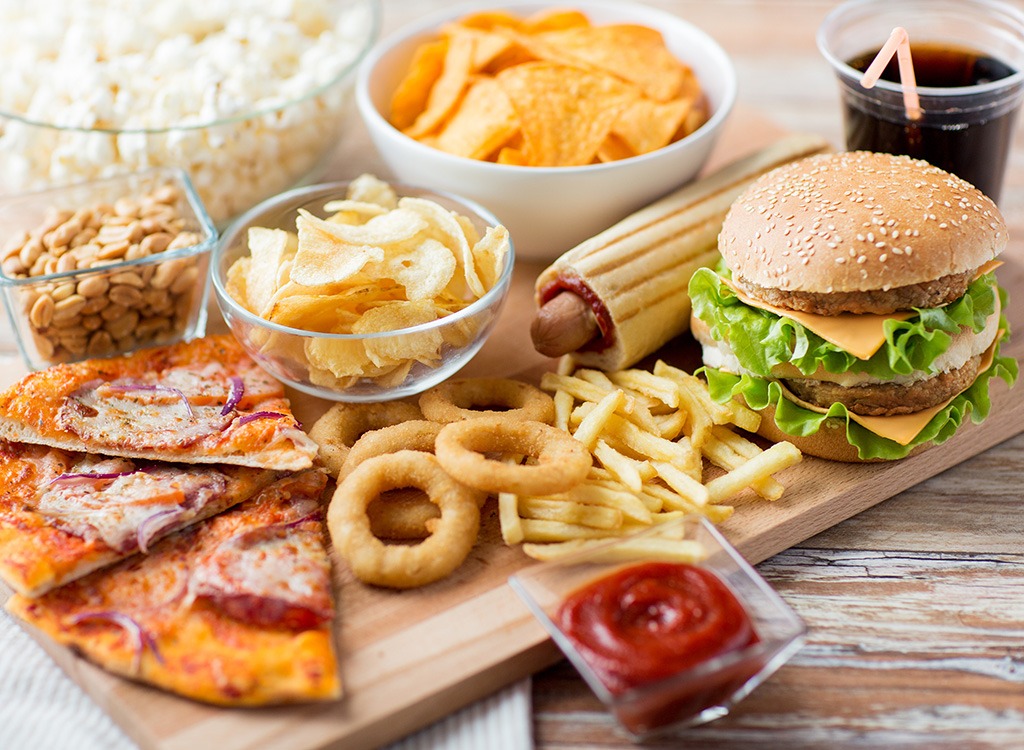 |
[TAG48]Easy to make full flavoured recipes. Life is too short for boring food! |
 |
[TAG49]Hello hello! Just wanted to pop in with a cute little life update. ♡ I’m delighted to share that our sweet son, Milo Alexander Martin, came to join our family |
 |
[TAG50]This vibrant lemony broccoli pesto pasta is quick and easy to make and full of fresh flavors. Your veggies, greens, and pasta…all in one gorgeous dish! ♡ We’re |
 |
[TAG51]HEALTHY & KID-FRIENDLY MEALS easy dinner recipes made in minutes. The Latest Recipes st. Patrick's Day Recipes Hello! I'm Sara! Welcome to Dinner at the Zoo! |
 |
[TAG52]This simple roasted carrot soup recipe is made with creamy tahini and topped with crispy za’atar chickpeas. Naturally gluten-free, vegetarian and vegan. If you |
 |
[TAG53]My longtime favorite flourless cake recipe is decadently rich and delicious, naturally gluten-free, and easy to make in under 1 hour! Trust me, this flourless |
 |
[TAG54]From comfort foods to indulgent dishes browse hundreds of recipes that your family will love and make over and over again. Cooking Classy has never been easier, |
 |
[TAG55]This vegetarian cabbage roll soup is filled with protein-rich lentils and all of the delicious flavors you love from traditional cabbage rolls. Naturally |
 |
[TAG56]These zesty roasted sweet potato and chickpea bowls are layered with sautéed spinach and brown rice and tossed with my favorite 4-ingredient chipotle tahini |
 |
[TAG57]A family food blog with hundreds of simple, tested and approved recipes. Find easy step-by-step photo cooking instructions and video recipes. |
 |
[TAG58]This classic matcha latte recipe is easy to make and customize to your liking and always so delicious. The older I get, the more I’m convinced that one of |
 |
[TAG59]This veggie-loaded broccoli cheese soup recipe is perfectly velvety and creamy without using heavy cream. Instant Pot, Crock-Pot and stovetop options all |
 |
[TAG60]find out hundres of delicous food recipes |
 |
[TAG61]This winter farro salad recipe is made with the most delicious blend of seasonal fruit, greens, nuts, crumbled cheese and tossed with a vibrant orange ginger |
 |
[TAG62]This lovely white wine sautéed mushrooms recipe is quick and easy to make, full of rich savory flavors, and can pair well as a side dish with many different |
 |
[TAG63]The food blog with mostly healthy recipes made with real, whole foods inspiring more people to get into the kitchen and cook something good. |
 |
[TAG64]This traditional Swedish meatballs recipe is bursting with rich, savory flavors and topped with a creamy gravy. Always so comforting served over mashed |
 |
[TAG65]A food blog with hundreds of quick and easy dinner recipes. Classics done right, incredible one pot recipes, Asian takeout at home and holiday feasting! |
Did you miss our previous article...
https://belovedsaffron.com/recipes/the-best-lemonpepper-chicken
.png)





